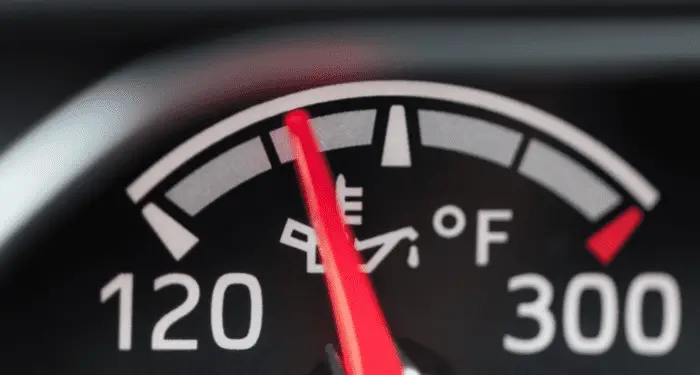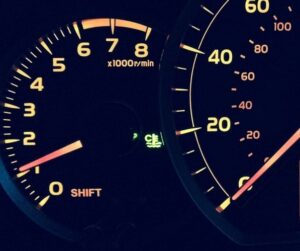If you’ve noticed your car temperature gauge increasing recently and want to know if it’s normal, we’ll answer it below.
The normal zone in the middle of the gauge dial is usually 60 to 100 C or 140 to 220 F. The temperature is within the car manufacturer’s guidelines as long as the needle stays within this middle section. Take into account that this number might go up or down depending on the situation, such as running climate control.
The question is usually asked because the driver has seen the gauge needle go up due to one of the events below :
- Towing
- Driving at higher speeds
- Using the aircon or other high energy auxiliary components.
- Stuck in a line of traffic for an extended period.
These four events will increase the coolant temperature but will always remain within the car’s normal operating boundaries.
Anything that causes the engine to work harder will increase its temperature.
With towing, the engine is pulling additional weight and has to work harder than it would normally do to reach the speed required.

Driving at higher speeds – especially for extended periods – will cause the engine to work at higher RPMs. Much of the excess heat will be taken away by the increased airflow through the grill and onto the coolant in the radiator but not all. Expect a slight increase in the temperature gauge in this scenario.
A serpentine belt operates aircon and other high energy use systems. This belt runs from the engine block, and an increase in the load – especially if these systems are used together – will cause the engine to work harder. More work = More heat.
Being stuck in a line of traffic will stop the flow of air over your car’s radiator. The radiator fan will automatically come on when the coolant temperature sensor detects an increase in temperature.

This will happen only when the gauge has already shown a noticeable journey upward toward the red section of the gauge. Waiting for the fan to come to life as you sit in a line of traffic can be stressful.
What Are The Two Different Temperature Gauge Styles?
- No digits – only an H at the top, often written in red, and a blue C at the bottom.
- Digits on the dial. These often start at 140 Fahrenheit (60 C) and go up to 250 Fahrenheit (120C) or even 300F.
The no digits design is more common, especially in standard cars. It removes the worry of drivers seeing the needle climb through the barrier of 200F and wondering if their car will overheat.

The lack of numbers on the more common designs prevents drivers from fixating on the temperature gauge and concentrating on the road.
However, the older style numbered gauges are still common on high-end performance cars that operate at higher normal coolant temperatures.
The optimal coolant temperature range for most cars is between 180F and 220 F. This is where the engine burns fuel most efficiently. Many car manufacturers design their engines to perform in this tighter range.

Each car manufacturer will have a different temperature programmed into the ECU, and should that temperature be exceeded, the car shuts down and does not restart. For most cars, the temperature is 230 F.
That being said, each name and model of car will have a slightly different normal.
How Do I Know What Is The Normal Coolant Temperature For My Car?
Modern cars operate at higher temperatures – up to 230F – as this helps with burning fuel more effectively and helps with improving fuel economy.
Older cars with carburetors had a lower normal temperature range, but unless your car is from the late 1980s or early 1990’s it probably has a fuel injection system instead.
Car manufacturers don’t routinely publish this information. Instead, they use the red section on the gauge to show drivers if the car is overheating and the engine cut-off devices should the ECU be given a higher than acceptable reading from the coolant temperature sensor.
Is There A Way To Increase The Normal Engine Coolant Operating Temperature?
Yes and No! There is no way of increasing the temperature level the car can reach before it overheats or shuts down.
However, using better-performance – coolant can take more heat away from the engine and thus lower the temperature. This allows the engine to operate under more stress and stay turned on longer than a car with lower quality coolant. Water alone is not recommended.
Most coolant isn’t concentrated and will be part distilled water. This works usually works fine as it will increase the boiling point of water from 100C (212F) to over 125C (225F).
Still, some drivers in more extreme environments may want even better performance and the ability to work their vehicles past these limits.
Waterless coolant is new to the market and, although more expensive, allows the engine to work at higher temperatures for longer. Evans Coolant claim that its waterless coolant has a boiling point of 375F (190C) and doesn’t vaporize either, reducing the pressure in the system. The other benefit of taking water out of the coolant system is that it removes the risk of corrosion.
In Conclusion
The ideal engine temperature, according to experts, is between 140 and 225 degrees Fahrenheit. However, the majority of vehicles do not have numerical temperature gauges. They display a hot-cold scale instead, with the needle ideally midway.
For most average motorists who occasionally add a little strain on the engine, there is no need to worry whether your car operates within normal temperature boundaries.
You’ll be fine if your coolant level is topped up and is of adequate concentration – not just water.
Only worry if the gauge reads above 220F or enters the red zone.




![Does Cruise Control Use Brakes? [ANSWERED] Cruise-control-buttons](https://carzaza.com/wp-content/uploads/2023/12/Cruise-control-buttons-300x150.png)

![Car Temperature Gauge Stays On Cold - [ALL CAUSES] Cold-temperature-gauge](https://carzaza.com/wp-content/uploads/2023/12/Cold-temperature-gauge-300x161.png)






